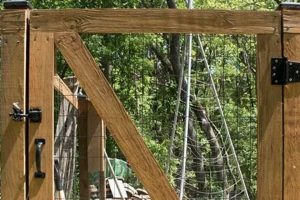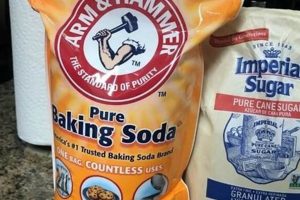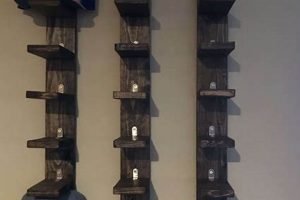Constructing a customized habitat for serpents involves creating a secure and appropriately sized living space tailored to the specific needs of the reptile. This process frequently entails utilizing readily available materials and employing basic construction techniques to yield a functional and aesthetically pleasing environment. For example, individuals may repurpose wooden cabinets or utilize prefabricated plastic components to assemble a terrarium suitable for their scaled companion.
The benefits of crafting a personalized habitat include cost-effectiveness, the ability to precisely control environmental parameters such as temperature and humidity, and the satisfaction derived from providing a tailored living space. Historically, reptile keepers often relied on commercially available enclosures. However, as access to information and resources has expanded, the practice of constructing bespoke habitats has become increasingly prevalent, allowing for greater customization and adaptation to specific species requirements.
The following sections will delve into the essential considerations for designing and building a suitable environment, including selecting appropriate materials, implementing effective heating and lighting solutions, and ensuring the security and safety of the inhabitant.
Essential Construction Recommendations
The following recommendations provide insights into optimizing the construction process, emphasizing safety, functionality, and the well-being of the serpent occupant.
Tip 1: Material Selection: Opt for non-toxic materials that are resistant to moisture and degradation. Melamine, PVC, and certain types of sealed wood are frequently employed. Avoid untreated woods susceptible to mold and decomposition.
Tip 2: Secure Enclosure Construction: Ensure all joints and seams are properly sealed to prevent escape. Utilize reptile-safe silicone sealant and reinforce corners with screws or brackets for added stability.
Tip 3: Ventilation is Paramount: Incorporate adequate ventilation to facilitate air exchange and prevent the buildup of stagnant air and humidity. Strategically placed vents, covered with fine mesh, are recommended.
Tip 4: Substrate Considerations: Select a substrate appropriate for the species. Options include paper towels (hygienic and easily replaceable), cypress mulch (maintains humidity), and aspen shavings (suitable for arid species). Avoid cedar and pine shavings due to their potential toxicity.
Tip 5: Temperature Gradient Implementation: Establish a thermal gradient by providing a basking area with a higher temperature and a cooler zone. This allows the serpent to thermoregulate effectively.
Tip 6: Hiding Places: Provide multiple hiding places within the enclosure, offering security and reducing stress. These can include commercially available hides, cork bark, or repurposed ceramic pots.
Tip 7: Safety Measures: Secure all heating elements and lighting fixtures to prevent direct contact with the serpent, mitigating the risk of burns. Utilize thermostats and timers to regulate temperature and light cycles.
These recommendations highlight the crucial aspects of habitat construction, emphasizing the importance of appropriate materials, secure construction, and species-specific environmental parameters.
The subsequent sections will explore advanced modifications and enhancements that can further optimize the functionality and aesthetics of the enclosure.
1. Secure Construction
Secure construction is a paramount consideration within the realm of creating custom-built habitats for serpents. The integrity of the enclosure directly correlates with the safety and well-being of the inhabitant. A compromised structure presents the risk of escape, exposing the animal to potential hazards within the surrounding environment and creating a burden for the owner. For example, poorly sealed joints or inadequate latching mechanisms can be exploited by a determined reptile, leading to a potentially dangerous situation for both the animal and the environment.
The significance of secure construction extends beyond preventing escape. It also serves to maintain the internal environmental conditions critical for the reptile’s health. A well-sealed enclosure effectively retains heat and humidity, ensuring the animal remains within its preferred physiological parameters. Conversely, gaps and cracks can lead to fluctuations in temperature and humidity, potentially causing stress, illness, or even death. Consider the example of a tropical snake species housed in an enclosure with inadequate sealing; the resulting loss of humidity could lead to shedding difficulties and respiratory problems.
In conclusion, secure construction is an indispensable element of any successful habitat project. From preventing escapes to maintaining stable environmental conditions, the structural integrity of the enclosure directly impacts the health and safety of the housed serpent. While aesthetic considerations may influence design choices, the primary focus must remain on creating a robust and secure environment that meets the specific needs of the species. Prioritizing this aspect ensures a safe, comfortable, and sustainable living space for the reptile.
2. Appropriate Ventilation
Proper air exchange is a crucial, yet often overlooked, aspect of creating customized habitats for serpents. The design and implementation of an adequate ventilation system directly influence the health, comfort, and overall well-being of the animal housed within.
- Prevention of Pathogen Buildup
Insufficient airflow fosters an environment conducive to the proliferation of bacteria, fungi, and other pathogens. Stagnant air traps moisture and organic waste, creating ideal breeding grounds. This can lead to respiratory infections, skin diseases, and other health problems. Adequate ventilation helps to remove airborne pathogens and maintain a healthier environment. For example, enclosures with inadequate ventilation often experience an increased incidence of scale rot or mouth rot in susceptible species.
- Regulation of Humidity Levels
Ventilation plays a vital role in regulating humidity levels within the habitat. Many serpent species require specific humidity ranges for proper shedding, hydration, and overall health. Excessive humidity can promote the growth of mold and bacteria, while insufficient humidity can lead to dehydration and shedding difficulties. A well-designed ventilation system allows for the controlled exchange of moist and dry air, enabling the maintenance of optimal humidity levels for the particular species. A well-ventilated enclosure prevents the humidity from rising to dangerous levels, preventing respiratory issues.
- Elimination of Waste Gases
Serpents, like all
living organisms, produce waste gases, including ammonia and carbon dioxide. In a poorly ventilated enclosure, these gases can accumulate to toxic levels, posing a serious threat to the animal’s health. Adequate ventilation facilitates the removal of these waste gases, maintaining a safe and breathable atmosphere. The absence of proper ventilation can lead to lethargy, reduced appetite, and, in severe cases, death. - Facilitation of Temperature Gradient
While often associated with heating elements, ventilation also contributes to the establishment and maintenance of a proper temperature gradient within the enclosure. By allowing for the exchange of air between different zones, ventilation helps to prevent the build-up of excessive heat in the basking area and ensures that the cooler end of the enclosure remains within the desired temperature range. This temperature gradient is essential for thermoregulation, allowing the serpent to choose its preferred body temperature. Ventilation plays a part on the air that is on the environment.
These facets underscore the critical importance of prioritizing ventilation when constructing a customized serpent habitat. Whether utilizing screen tops, strategically placed vents, or powered fans, incorporating an effective ventilation system is essential for promoting a healthy and thriving environment. Prioritizing this consideration ensures the long-term well-being of the animal and contributes to the success of the construction endeavor. Air is not only necessary but a need on diy snake enclosure.
3. Temperature Regulation
Temperature regulation is a foundational element in the construction of habitable environments for snakes. Unlike mammals, snakes are ectothermic, relying on external heat sources to maintain optimal body temperatures. The efficacy of temperature regulation within a constructed environment directly influences the snake’s physiological functions, including digestion, immune response, and activity levels. Insufficient attention to this aspect can lead to compromised health, reduced lifespan, or even mortality. For example, an enclosure lacking a proper thermal gradient will prevent a snake from effectively thermoregulating, potentially leading to chronic stress and increased susceptibility to disease. The capacity to establish and maintain appropriate temperature zones represents a primary objective in building an effective custom habitat.
Achieving precise temperature control within a constructed environment requires a multifaceted approach. The incorporation of heating elements, such as under-tank heaters, ceramic heat emitters, or heat lamps, must be coupled with accurate monitoring and regulation. Thermostats are essential for preventing overheating and maintaining stable temperature ranges. Furthermore, the strategic placement of these heat sources is crucial for establishing a thermal gradient, allowing the snake to move between warmer and cooler areas to regulate its body temperature according to its needs. The use of digital thermometers and hygrometers facilitates accurate monitoring of both temperature and humidity levels, enabling adjustments to the heating system as necessary. Many snake keepers utilize infrared temperature guns to verify surface temperatures within the enclosure and ensure the thermal gradient is properly established.
In summary, temperature regulation forms a critical component of constructing a functional habitat. The provision of a suitable thermal gradient, facilitated by appropriate heating elements and accurate monitoring, is essential for the health and well-being of the snake. The challenges lie in selecting appropriate equipment, calibrating the system, and continuously monitoring environmental conditions to adapt to changing needs. By understanding and prioritizing the principles of temperature regulation, individuals can create safe and comfortable environments conducive to the thriving of these reptiles.
4. Species-Specific Substrate
Selecting a suitable substrate is a crucial aspect of constructing a functional and healthy habitat. The substrate directly impacts the reptile’s environment, influencing humidity levels, hygiene, and overall well-being. Consideration must be given to the natural habitat of the snake when choosing a substrate. Utilizing appropriate materials tailored to the species is not merely aesthetic; it is fundamental to providing a supportive and enriching environment.
- Humidity Management
Different snake species thrive in varying humidity levels. Arid-dwelling species such as corn snakes and ball pythons require substrates that maintain low humidity, such as aspen shavings or recycled paper products. Conversely, tropical species like green tree pythons and emerald tree boas need substrates that retain moisture, such as cypress mulch or coconut fiber. The correct substrate helps replicate the natural moisture conditions of the snake’s native environment, preventing health issues like respiratory infections or shedding problems. Incorrect substrate leads to complications on diy snake enclosure, making it prone to health problems.
- Burrowing and Security
Many snake species exhibit burrowing behaviors, using the substrate to create hiding places and feel secure. Substrates like loose soil, peat moss, or a mixture of both allow for natural digging and burrowing, reducing stress and promoting overall well-being. A snake without proper burrowing opportunities may experience chronic stress, which can compromise its immune system. For instance, a hognose snake, a known burrower, should be provided with a substrate that allows it to engage in this natural behavior.
- Ease of Cleaning and Hygiene
The substrate also plays a role in maintaining a hygienic environment. Certain substrates, like paper towels or newspaper, are easy to clean and replace, making them suitable for quarantine or snakes with specific health needs. Other substrates, such as bioactive mixes, are designed to support a self-cleaning ecosystem with beneficial invertebrates that break down waste. Regardless of the chosen substrate, regular spot cleaning and complete substrate changes are essential for preventing the buildup of harmful bacteria and ammonia. Using an easily cleanable, antibacterial, and fast maintainance substrate prevent from building diseases.
- Digestibility and Safety
The substrate must be non-toxic and indigestible to prevent accidental ingestion and potential impaction. Small, particulate substrates like sand or gravel should be avoided, as they can be accidentally ingested during feeding and cause blockages in the digestive tract. Larger, safe options like cypress mulch or coconut fiber are generally preferred. Additionally, substrates should be free of sharp edges or splinters that could injure the snake. Many injuries happens due to the selection of unsafe components, its a main risk of snake enclosure.
The substrate is not merely a decorative element; it is a functional component that directly impacts the health and welfare of the serpent. Selection should be guided by the species’ natural history, behavioral needs, and environmental requirements. A properly selected and maintained substrate contributes to the creation of a thriving and enriching environment.
5. Safe Materials
The selection of appropriate materials constitutes a cornerstone of constructing a secure habitat for serpents. The direct contact between the animal and the enclosure necessitates a stringent evaluation of the materials’ inherent properties, focusing on toxicity, durability, and resistance to environmental degradation. The use of unsuitable substances can trigger a cascade of adverse effects, ranging from dermal irritation and respiratory distress to systemic poisoning and long-term health complications. For example, untreated wood can harbor mold and bacteria, while certain plastics may leach harmful chemicals when exposed to heat or humidity. The correlation between material selection and the animal’s well-being demands meticulous attention to detail.
Practical application of this principle involves a careful vetting process for all materials incorporated into the enclosure’s construction. Reptile-safe silicone sealant, for instance, is explicitly formulated to be non-toxic and resistant to fungal growth, mitigating potential risks associated with moisture exposure. Similarly, the utilization of PVC or melamine boards, known for their impermeability and ease of cleaning, offers a robust and hygienic alternative to porous materials. However, it’s imperative to ensure that these boards are properly sealed to prevent the release of volatile organic compounds (VOCs), which can pose a threat to the snake’s respiratory system. Real-world scenarios underscore the criticality of informed decision-making; anecdotes abound of reptiles succumbing to illness due to exposure to inappropriate paints, varnishes, or cleaning agents.
In summary, the prudent selection of materials is an indispensable aspect of habitat construction. Challenges arise in navigating the vast array of commercially available products and discerning their suitability for reptile environments. However, a thorough understanding of material properties, coupled with a commitment to prioritizing animal safety, can mitigate potential risks. The broader theme underscores the ethical responsibility of reptile keepers to provide environments that not only meet the physical needs of their animals but also safeguard their long-term health and well-being.
Frequently Asked Questions
The following addresses common inquiries regarding the construction of a secure and functional habitat.
Question 1: What are the most crucial considerations when constructing a safe and secure enclosure?
Structural integrity and escape-proofing are paramount. This necessitates robust construction techniques, secure latching mechanisms, and the use of non-toxic, durable materials that can withstand the reptile’s activity and environmental conditions.
Question 2: How can appropriate ventilation be ensured within a constructed environment?
Strategically placed vents, typically covered with fine mesh, facilitate air exchange and prevent the buildup of stagnant air and humidity. The size and placement of vents should be calibrated to the species’ specific requirements, balancing airflow with the maintenance of appropriate temperature and humidity gradients.
Question 3: What methods are effective for regulating temperature within a constructed habitat?
A combination of heating elements, such as under-tank heaters, ceramic heat emitters, or heat lamps, coupled with accurate thermostats, enables the creation of a thermal gradient. The strategic placement of these elements allows the snake to thermoregulate effectively.
Question 4: How does substrate selection contribute to the health and well-being of the housed serpent?
The choice of substrate directly impacts humidity levels, hygiene, and the reptile’s ability to express natural behaviors. Species-appropriate substrates, such as aspen shavings for arid species or cypress mulch for tropical species, promote optimal health and comfort.
Question 5: What materials should be avoided in the construction of a reptile enclosure, and why?
Untreated wood is susceptible to mold and bacterial growth. Certain plastics may leach harmful chemicals when exposed to heat or humidity. These materials pose a significant risk to the reptile’s health and should be avoided in favor of reptile-safe alternatives.
Question 6: How can the risk of accidental injury be minimized within a customized habitat?
Sharp edges, exposed heating elements, and unsecured decorations present potential hazards. All components should be thoroughly inspected and appropriately secured to prevent accidental injury.
Proper planning and meticulous construction are essential for creating a successful environment. Prioritizing safety, functionality, and the specific needs of the housed serpent is essential.
The following sections will delve into more advanced design considerations, including bioactive setups and automated environmental control systems.
Conclusion
The construction of customized habitats, otherwise known as diy snake enclosure, presents both opportunities and challenges. This comprehensive exploration has addressed critical elements, including material selection, structural integrity, ventilation, temperature regulation, and substrate suitability. The principles outlined herein serve as a foundation for responsible reptile husbandry, emphasizing the primacy of animal welfare in habitat design and construction. Ignoring these factors leads to a high chance of health problems to snake or even death.
Ultimately, the success of diy snake enclosure rests upon informed decision-making and meticulous execution. Continued research, observation, and adaptation remain essential for optimizing these customized environments and ensuring the health and well-being of their inhabitants. The ongoing pursuit of best practices in reptile husbandry necessitates a commitment to continuous learning and refinement, furthering both the art and science of creating optimal living spaces for these fascinating creatures.







